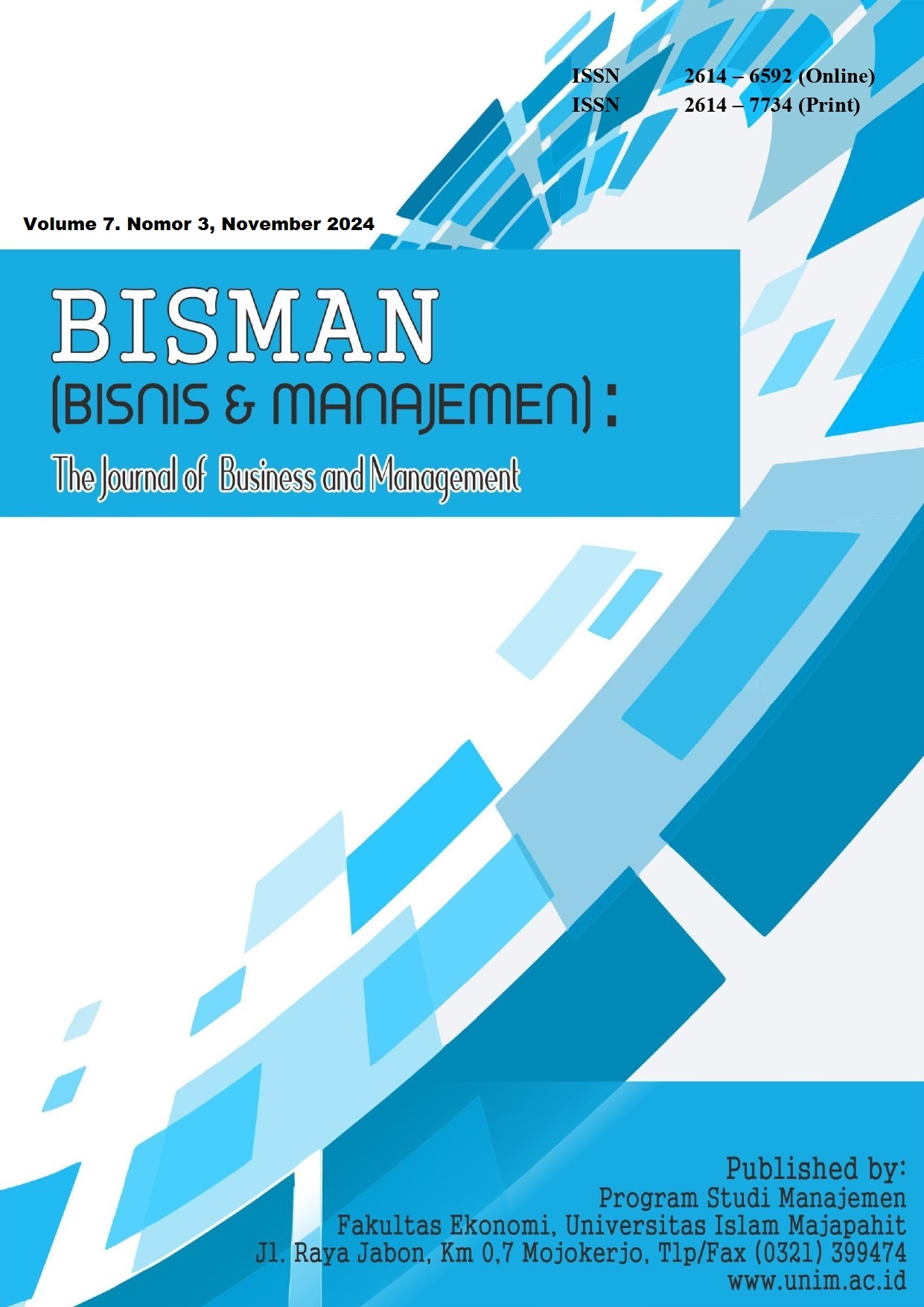Increasing Brand Image through Product Quality and Hedonic Lifestyle
DOI:
https://doi.org/10.36815/bisman.v7i3.3281Keywords:
Product Quality, Hedonic Lifestyle, Brand ImageAbstract
This study aims to analyze the influence of Product Quality and Hedonic Lifestyle on the Brand Image of Wuling-branded vehicles in the Jepara region. The research employs a survey method with an accidental sampling technique, involving 100 respondents. Data collected includes both primary and secondary sources, analyzed using multiple linear regression. The findings reveal that an improvement in product quality significantly contributes to Wuling's brand image, with a regression coefficient of 0.386, indicating that a 1% increase in product quality enhances the brand image by 0.386%. Additionally, hedonic lifestyle positively impacts brand image, with a coefficient of 0.210. These results underline the importance of product quality and engaging marketing strategies in attracting consumer interest. The uniqueness of this research lies in its focus on the interaction between product quality and hedonic lifestyle within the context of the automotive market in Jepara, a topic rarely explored in existing literature. This study provides new insights for Wuling manufacturers to formulate more effective marketing strategies while emphasizing continuous attention to product quality to maintain customer loyalty in a competitive market. Consequently, this research not only contributes to marketing theory development but also offers practical implications for Indonesia's automotive industry.
References
Ali, M. et al. (2023) ‘Journal of Economic Behavior and Organization Getting sick for profit?? The impact of cumulative ICT and management changes on long term sickness absence R’, 212, pp. 659–688. Available at: https://doi.org/10.1016/j.jebo.2023.06.008.
Alzate, M., Arce-urriza, M. and Cebollada, J. (2022) ‘Journal of Retailing and Consumer Services Mining the text of online consumer reviews to analyze brand image and brand positioning’, Journal of Retailing and Consumer Services, 67(April), p. 102989. Available at: https://doi.org/10.1016/j.jretconser.2022.102989.
Cristina, T. and Chi, C. (2019) ‘Ethnic marketing to the global millennial consumers?: Challenges and opportunities’, Journal of Business Research, 103(February), pp. 261–274. Available at: https://doi.org/10.1016/j.jbusres.2019.01.052.
Evers, N. et al. (2023) ‘Unraveling business model innovation in firm internationalization?: A systematic literature review and future research agenda’, Journal of Business Research, 158(January), p. 113659. Available at: https://doi.org/10.1016/j.jbusres.2023.113659.
Gerke, A., Benson-rea, M. and Odlin, D. (2023) ‘SME upgrading in emerging market clusters?: The case of Taiwan ’ s bicycle industry’, Journal of Business Research, 164(January 2022), p. 113967. Available at: https://doi.org/10.1016/j.jbusres.2023.113967.
Gregori, P., Holzmann, P. and Wdowiak, M.A. (2021) ‘For the sake of nature?: Identity work and meaningful experiences in environmental entrepreneurship’, Journal of Business Research, 122(October 2019), pp. 488–501. Available at: https://doi.org/10.1016/j.jbusres.2020.09.032.
Haftor, D.M., Costa-climent, R. and Ribeiro, S. (2023) ‘A pathway to bypassing market entry barriers from data network effects?: A case study of a start-up ’ s use of machine learning’, Journal of Business Research, 168(August), p. 114244. Available at: https://doi.org/10.1016/j.jbusres.2023.114244.
Hong, C. et al. (2023) ‘The role of harmonized Landsat Sentinel-2 ( HLS ) products to reveal multiple trajectories and determinants of cropland abandonment in subtropical mountainous areas’, Journal of Environmental Management, 336(February), p. 117621. Available at: https://doi.org/10.1016/j.jenvman.2023.117621.
Jaroenjitrkam, A. et al. (2023) ‘Pulling together by paying together?: The effect of product market competition on TMT incentive dispersion’, Journal of Business Research, 165(December 2021), p. 114045. Available at: https://doi.org/10.1016/j.jbusres.2023.114045.
Kingdom, U. (2023) ‘Internationalization of emerging market multinational enterprises?: A systematic literature review and future directions’, 164(April). Available at: https://doi.org/10.1016/j.jbusres.2023.114002.
Kovalchuk, M., Gabrielsson, M. and Rollins, M. (2023) ‘Industrial BRAND-personality formation in a B2B stakeholder network?: A service-dominant logic approach’, Industrial Marketing Management, 114(November 2022), pp. 313–330. Available at: https://doi.org/10.1016/j.indmarman.2023.05.006.
Sambashiva, K., Rao, B. and Acharyulu, G.V.R.K. (2021) ‘ScienceDirect Examining ePWOM-purchase intention link in Facebook brand fan pages?: Trust beliefs , value co-creation and brand image as mediators’, IIMB Management Review, 33(4), pp. 309–321. Available at: https://doi.org/10.1016/j.iimb.2021.11.002.
Shah, P. et al. (2023) ‘Opportunities and challenges in food entrepreneurship?: In-depth qualitative investigation of millet entrepreneurs’, Journal of Business Research, 155(PB), p. 113372. Available at: https://doi.org/10.1016/j.jbusres.2022.113372.
Shi, W. et al. (2022) ‘An examination of maximum legal application rates of dairy processing and associated STRUBIAS fertilising products in agriculture’, 301(October 2021). Available at: https://doi.org/10.1016/j.jenvman.2021.113880.
Snyder, H. et al. (2022) ‘Consumer lying behavior in service encounters’, Journal of Business Research, 141(December 2021), pp. 755–769. Available at: https://doi.org/10.1016/j.jbusres.2021.11.075.
Tey, L. et al. (2023) ‘Acidification and solar drying of manure-based digestate to produce improved fertilizing products’, 336(November 2022). Available at: https://doi.org/10.1016/j.jenvman.2023.117664.
Wu, J. et al. (2023) ‘The effects of inward FDI communities on the research and development intensity of emerging market locally domiciled firms?: Partial foreign ownership as a contingency’, Journal of Business Research, 156(May 2021), p. 113487. Available at: https://doi.org/10.1016/j.jbusres.2022.113487.
Downloads
Published
Issue
Section
License
Copyright (c) 2024 Bisman (Bisnis dan Manajemen): The Journal of Business and Management

This work is licensed under a Creative Commons Attribution-NonCommercial 4.0 International License.
Pemberitahuan Hak Cipta
- Seluruh materi yang terdapat dalam situs ini dilindungi oleh undang-undang. Dilarang mengutip sebagian atau seluruh isi situs web ini untuk keperluan komersil tanpa persetujuan dewan penyunting jurnal ini.
- Apabila anda menemukan satu atau beberapa artikel yang terdapat dalam Bisman (Bisnis dan Manajemen): The Journal of Business and Management yang melanggar atau berpotensi melanggar hak cipta yang anda miliki, silahkan laporkan kepada kami, melalui email pada Priciple Contact.
- Semua Informasi yang terdapat di Bisman (Bisnis dan Manajemen): The Journal of Business and Management bersifat akademik. Bisman (Bisnis dan Manajemen): The Journal of Business and Management tidak bertanggung jawab terhadap kerugian yang terjadi karana penyalah gunaan informasi dari situs ini.





